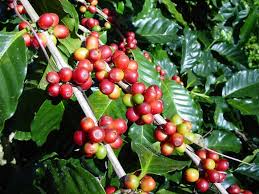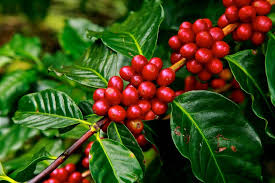Some agro-ecological conditions are known to influence Arabica Coffee farming. These include soil, land, topography, the amount and distribution of rainfall, altitude, temperature, humidity, and wind effects.
Soil Requirements for Arabica Coffee
Arabica Coffee can grow on different soil types but does well on well-drained volcanic soils. For best root establishment, it requires a fertile, well-aerated, free-draining, slightly acidic, deep soil with reasonable humus content and a minimum depth of about 1m before roots reach an impermeable soil.
Arabica Coffee will not tolerate water logging or ‘wet feet’.
The best or ideal soils are volcanic red earth or sandy loams with good structure and texture and rich in organic matter.
Avoid heavy clay or poor-draining soils for good productivity. In addition, the soil should be just slightly acidic, with a pH range of 5.5–6.5 within which it would be well supplied with all the essential major plant nutrients. Low or high pH will limit crop performance.
Read Also: Feed Lot Fattening of Rams Practice
Altitude Considerations for Arabica Coffee Cultivation

An elevation between 1,200m and 2,500m above sea level is ideal for Arabica Coffee growing. Low elevation Arabica Coffee does not possess the best quality required by world markets. Based on cup tests, areas within 1,500 to 2,500m clearly produce superior quality/premium coffee.
High elevation improves the quality of the bean and potential cupping quality. Due to a delay in ripening caused by cooler weather associated with higher altitudes, the inherent characteristics of acidity, aroma, and bold bean can fully develop.
Bold bean is classified as being between large and medium sized bean, with its width/length ratio bigger than that of a large bean.
Temperature Requirements for Optimal Growth
Since most Arabica growing areas in Uganda are above 1,500m above sea level, the potential to produce unique Arabica Coffee for specialty markets is high. Arabica Coffee prefers a cool temperature with an optimum daily temperature range of 15°-24°C (59°-75°F).
Temperatures higher than 24°C (75°F) cause plant stress, which leads to a cessation of photosynthesis. Mean temperatures of less than 15°C (59°F) also limit plant growth and are considered sub-optimal. As Arabica Coffee is susceptible to frost damage, the use of shade trees to reduce its incidence is recommended.
Rainfall and Humidity Requirements in Coffee Cultivation
Arabica Coffee requires a rainfall range of 1,200-1,800mm per annum, which is well distributed over a period of 9 months. Both the total amount and the distribution pattern are important.
Unless there is regular rainfall, young, newly planted coffee trees should be irrigated (or hand watered if irrigation is not available) at least twice a week to ensure that the newly planted seedlings become established.
Also, if rain is inadequate during growth, supplemental watering/irrigation to induce uniform flowering and good fruit formation should be carried out. A fairly regular/frequent rainfall pattern throughout the berry development stage is required.
A good soaking of 50mm every 10 days or approximately 20 litre (1 jerrycan of water per plant per day) is required. Rainfall also triggers the ripening process. Without adequate rainfall/moisture, flowering may extend over many months, making plans for harvesting more difficult and other farm management practices unpredictable.
Excessive drought can cause the coffee tree to become dehydrated, leading to its defoliation and/or increased attacks of plagues such as the red spider mite, leaf miner, or the coffee berry borer. Excessive rainfall can also affect the flowering of the coffee tree by either diminishing it or destroying it altogether.
Thus, locating coffee plantings near a water supply for possible irrigation as well as for processing of cherries is desirable. Water requirements can also be reduced by the use of suitable, well-established shade trees and mulch.
Wind Effects on Coffee Growth in Agricultural Systems

High winds have an adverse effect on coffee growth because they can cause excessive evapotranspiration and increase the demand for irrigation. Therefore, in windy areas, the inclusion of windbreakers and shade trees is desirable.
Arabica Coffee Production Systems and Their Management
There are two types of Arabica Coffee growing systems, i.e., monocropping (pure stand) and intercropping (mixed stand). Each system has its own advantages and disadvantages.
1. Monocropping System: Pure Stand Cultivation in Coffee Farming
Monocropping is an agricultural practice of growing coffee as a single crop or pure stand on one piece or plot of farmland.
Advantages and Disadvantages of Arabica Coffee Monocropping
1. Advantages: The coffee growing requirements, planting, maintenance including pest control and harvesting are conducted on the same crop across the farmed land, resulting in a lower cost of production; cultivating one kind of crop is much easier in terms of the knowledge and experience needed; requires less labour/not labour intensive.
2. Disadvantages: May lead to food insecurity as, while increased coffee yields are campaigned for, the need for food to feed households is critical; growing the same coffee crop year after year depletes valuable soil nutrients that plants rely on, thus necessitating increased amounts of fertilizers; high livelihood risk in case of crop failure.
2. Intercropping System: Mixed Stand Cultivation in Coffee Agriculture
Intercropping, also known as mixed cropping or co-cultivation, is a type of farming that involves planting coffee alongside one or more other different crops in the same field. While the coffee is still young, an area of land between the young coffee trees can be utilized to grow various crops, mainly food crops.
Recommended intercrops for coffee in Uganda include bananas, non-climbing Phaseolus beans, soya-beans, groundnuts, and tomatoes.
However, these must be confined to the central 2m of the inter-row, leaving a clear 0.5m between them and the coffee tree.
Two crops can be grown per year during the first two years; it is important to note, however, that growing beans on the same plots, particularly in the humid areas, may result in serious problems with aphids. This practice should therefore be avoided.
Maize, cassava, and potatoes are high nutrient demand crops and are not recommended. The coffee–banana intercropping is a major type of coffee system in Uganda that is encouraged. During the phase of early establishment, bananas a permanent crop commonly grown with coffee may be established.
The banana provides shade for the young coffee in the early years, while in later years the fallen banana leaves serve as mulch cover and manure for coffee.
However, if planted in large numbers, bananas may compete with coffee plants for nutrients. For this reason, a banana/coffee ratio of 1:4 is recommended until ongoing research results are validated. In this combination, each banana plant shades four coffee bushes and each coffee bush is shaded by only one banana plant.
Read Also: General Principles of Goat Production
Advantages and Disadvantages of Coffee–Banana Intercropping

1. Advantages: Growing bananas in a young coffee field ensures that there is some return from the land before the coffee reaches the productive stage; intercropping banana and coffee reduces the income risk faced by farmers who cultivate a monocrop.
Return to labour is often higher in banana–coffee systems, increasing total revenue/inflow per unit area by about 30% compared to coffee monocropping; improves coffee quality and provides food to the household; increases yields by intensifying crop management of both bananas and coffee.
The banana provides shade for coffee, reducing stress caused by extreme temperatures and strong winds; the banana crop residues provide mulch that improves soil fertility due to the large biomass turnover from rotting banana leaves.
The permanent canopy and root systems of banana reduce soil erosion by lessening the impact of rainfall on the topsoil and reducing run-off; reduces greenhouse gas (GHG) emissions by increasing carbon stocks from both banana and coffee.
2. Disadvantages: Increases competition for water, nutrients, and light; is labour intensive and requires extensive management and care; if the shade is too dense, the yield potential of coffee is reduced and the coffee will respond poorly to fertilizer.
Do you have any questions, suggestions, or contributions? If so, please feel free to use the comment box below to share your thoughts. We also encourage you to kindly share this information with others who might benefit from it. Since we can’t reach everyone at once, we truly appreciate your help in spreading the word. Thank you so much for your support and for sharing!

